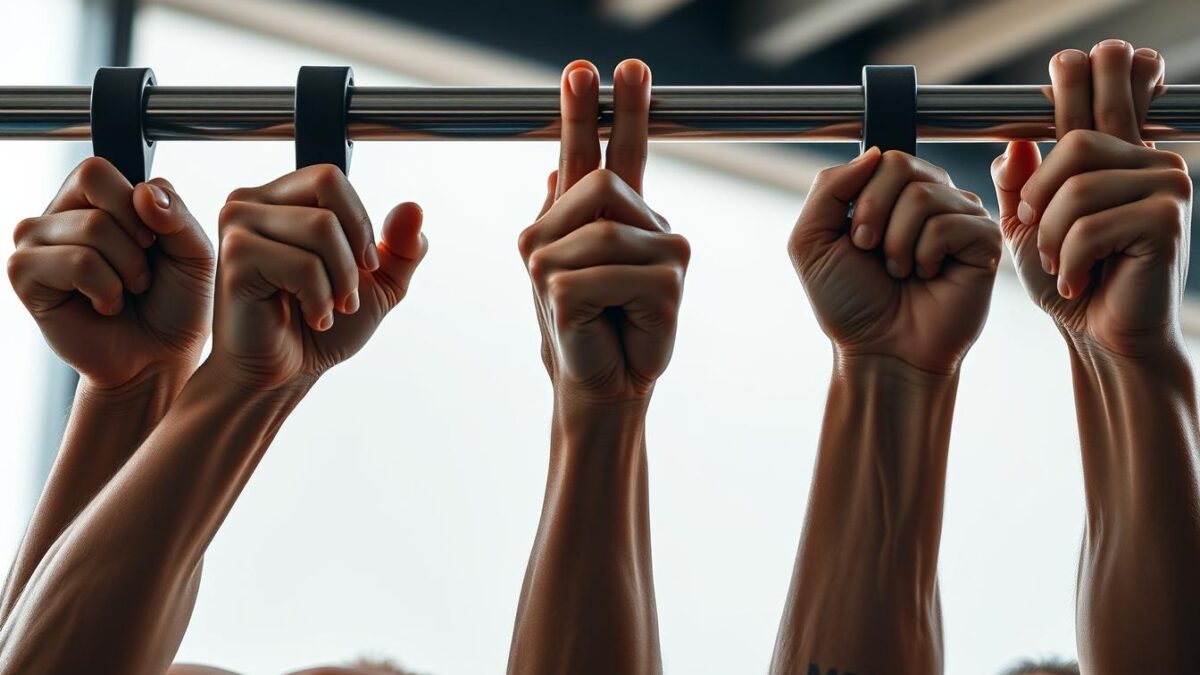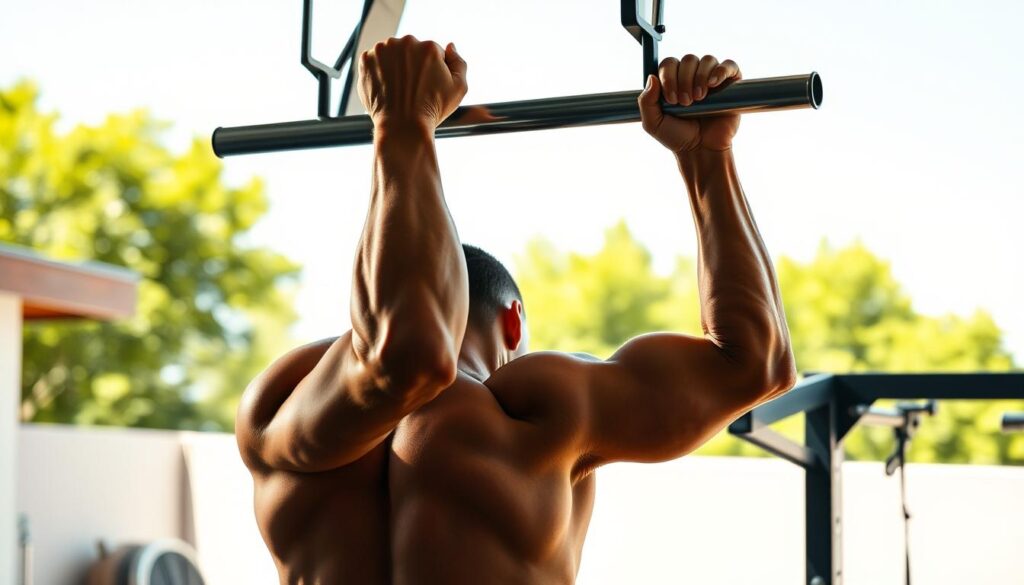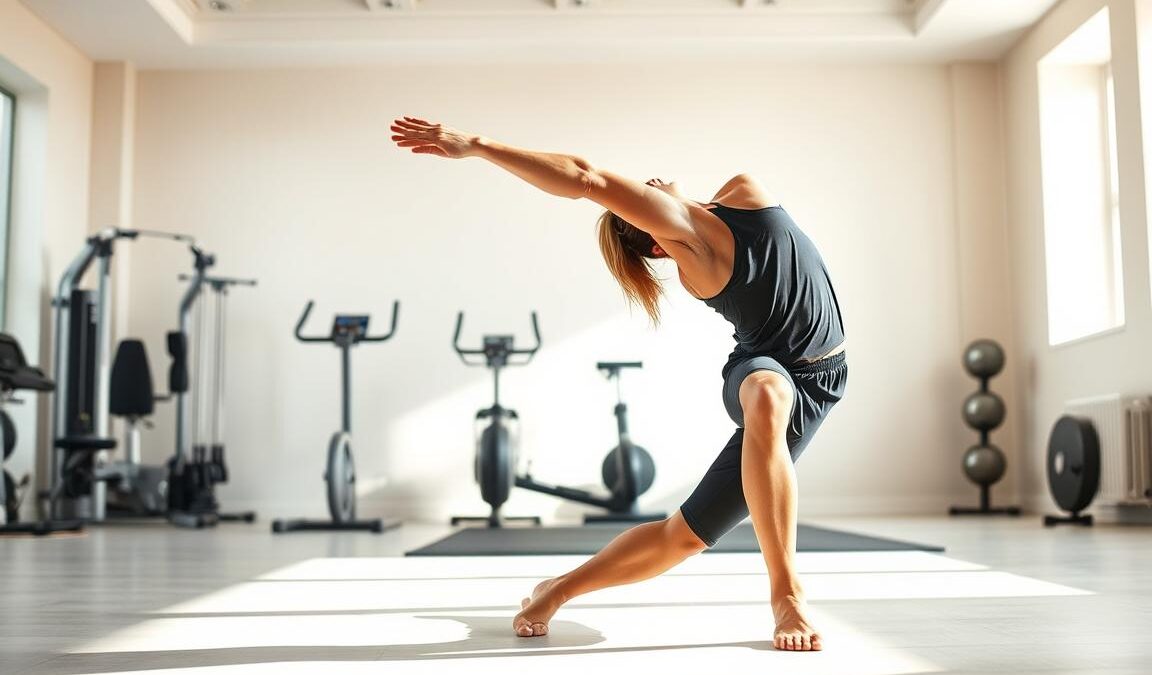
Pull-Up Grip Variations and Their Muscle Targets
Ready to boost your strength training? Pull-up grip variations are your secret to unlocking new muscle targets. They help you work out more efficiently. By changing grips, you can target different muscles, improving strength and stability.
Whether you’re just starting or have some experience, learning these grips is key. They can change your workout for the better. Let’s explore how pull-up variations can enhance your training.
Understanding Pull-Up Grip Variations
There are many pull-up grip variations, each with its own purpose. Exploring these can change how you do upper body workouts. The right grip helps you focus on muscle engagement, making each rep more effective.
Using different grips not only builds strength but also fixes muscle imbalances. For example, a pronated grip works the back muscles differently than a supinated grip. By trying different grips, you work out all muscle groups evenly, leading to balanced growth.
Knowing which grips to use can make your workouts better. It lets you target specific areas of your upper body more effectively. Try different grips often to add variety to your fitness journey.
Pronated Grip: The Classic Pull-Up
The pronated grip, also known as the classic pull-up, is great for building upper body strength. It mainly works the latissimus dorsi. It also engages the biceps, shoulders, and forearms. If you want to strengthen your back, this grip is perfect.
Muscle Targets of the Pronated Grip
The classic pull-up mainly targets the latissimus dorsi. This grip helps you pull efficiently, focusing on your lats. Other muscles involved are:
- Biceps: Helps with the pulling action.
- Shoulders: Keeps your body stable.
- Forearms: Important for grip strength.
Tips for Performing Pronated Pull-Ups
Getting good at the classic pull-up takes practice and the right technique. Here are some tips to improve:
- Begin with your hands shoulder-width apart for a better grip.
- Use your core to stay stable during the exercise.
- Pull up until your chin clears the bar.
- Lower down slowly to work your muscles harder.
- Try variations like adding weights or changing grip width if you’re ready.
Supinated Grip: The Chin-Up
The supinated grip, also known as the chin-up, focuses on the biceps while also working the lats and lower chest. It’s great for boosting arm strength and works well for the upper body and core. Knowing how it targets muscles can help you use chin-ups better in your workouts.
Muscle Targets of the Supinated Grip
Chin-ups target several muscle groups effectively:
- Biceps: The supinated grip really works the biceps, making it perfect for building arm strength.
- Lats: Your lat muscles get a good workout too, giving you a full back exercise.
- Lower Chest: Chin-ups also strengthen your lower chest, improving both looks and strength in the upper body.
Benefits of Supinated Grip Variations
Chin-ups have many benefits over other pull-up styles:
- They activate the biceps more, leading to quicker muscle growth and strength.
- They also boost grip strength, which is good for fitness and everyday tasks.
- Plus, they help stabilize the shoulders, reducing injury risk in other exercises.
Wide Grip Pull-Ups
Wide grip pull-ups are a powerful exercise for those focusing on back development. They require more effort from the latissimus dorsi muscles. This makes them a top choice for impressive back muscle growth.
By using a wider grip, you reduce bicep involvement. This lets your back muscles take the lead.
Muscle Targets of Wide Grip Pull-Ups
Wide grip pull-ups aim to strengthen and widen your back. They work your lats intensely, helping you achieve a V-shape physique. This exercise also engages the trapezius and rhomboids, supporting balanced back growth.
Knowing which muscles are targeted helps you get the most out of your workout. It ensures you reach your fitness goals.
Challenges and Techniques for Wide Grip
Wide grip pull-ups are great for back development but can be tough for beginners. The wider stance may put strain on your shoulders if not done right. Here’s how to do it effectively:
- Start with your hands wider than shoulder-width apart.
- Engage your core and pull up smoothly.
- Squeeze your shoulder blades together at the top.
Practicing these techniques boosts your strength and endurance in wide grip pull-ups. It helps target your back muscles better for optimal development.
Mixed Grip Pull-Up Variations
Mixed grip pull-ups mix two grips: one hand pulls in a traditional way, while the other uses an underhand grip. This setup gives your muscles a different angle to work on, helping you get stronger. Adding mixed grip pull-ups to your workout routine boosts your grip strength and engages more muscles in your back and arms.
This method works your lats and biceps in special ways, making your upper body stronger. It’s great for those who want to do more reps and improve their control. Mixed grip pull-ups are a versatile and challenging way to take your pull-ups to the next level.

Neutral Grip Pull-Ups
Neutral grip pull-ups are a great way to work out your upper body. Your palms face each other, making it easier for many people. This exercise targets your lats, biceps, and deltoids, giving you a full upper body workout.
Muscle Targets of Neutral Grip Pull-Ups
Neutral grip pull-ups work several muscles:
- Lats: Important for pulling strength and upper back growth.
- Biceps: They get a lot of work when you pull up.
- Deltoids: They help keep your shoulder joint stable.
- Forearm muscles: They’re key for grip strength.
Benefits of Using a Neutral Grip
Neutral grip pull-ups offer many benefits:
- They put less strain on your shoulders, making them easier to do.
- They help strengthen your forearms, thanks to the grip needed.
- They provide a balanced workout for your upper body.
- They’re versatile and can be done with different equipment like a pull-up bar or straps.
Pull-Up Grip Variations Explained
Exploring different pull-up grips can spice up your workout. Each grip changes how you work your muscles and adds variety to your routine. By trying out different grips, you can target different muscles, leading to better balance and less injury risk.
Using different grips does more than just work your muscles. It keeps your workouts exciting by changing up the challenge. This variety not only keeps things interesting but also boosts your strength and performance.
Adding various pull-up grips to your routine helps fix muscle imbalances. Each grip works different muscles, helping you build a balanced body. It’s a chance to try new things and discover your hidden strengths.
Grenade Grip Pull-Ups
Grenade grip pull-ups add a new twist to your workouts. They use special balls to challenge your upper body and grip strength. This exercise mainly works your lats and biceps, making your arms and back stronger.
Muscle Focus and Benefits of Grenade Grip
Grenade grip pull-ups focus a lot on your grip strength. The round handles need more forearm effort. This leads to:
- Increased lat and bicep development
- Improved grip strength and endurance
- Alleviation of wrist and elbow joint pain
Adding grenade grip pull-ups to your routine can make your upper body more balanced. It also strengthens your grip. Try it out and see how it changes your workouts!
Towel Grip Pull-Ups
Towel grip pull-ups offer a fresh take on the traditional pull-up. They test your grip and forearm strength in a new way. Using a towel over the bar, this exercise works your lats and biceps harder. It also boosts the workout’s intensity, making it a great addition to your routine.
Adding towel grip pull-ups to your workouts gets you ready for grip challenges in other exercises. Rope climbs are a good example. This exercise is perfect for improving your grip strength.
Engaging Your Forearms and Grip Strength
Towel grip pull-ups focus on your forearm workout in a unique way. Your grip strength is key for many activities, both in and out of the gym. This exercise works multiple muscles while focusing on your grip.
- Improves grip strength
- Targets forearm muscles
- Enhances overall pulling strength
- Prepares for functional movements like rope climbs
Getting good at towel grip pull-ups can really help your fitness journey. It makes you better at handling grip challenges. This can improve your performance in many exercises, boosting your overall fitness.
Choosing the Right Grip for Your Goals
Choosing the right grip for pull-ups is key to reaching your fitness goals. Are you looking to boost strength, build muscle, or up your endurance? Each grip has its own benefits, helping you target different muscles.
Mixing up your grip choices can make your workouts more effective. For example, the pronated grip is great for upper body strength. On the other hand, the supinated grip is better for bicep growth. This variety keeps your training interesting and helps you progress.
Setting clear goals is essential in picking the right grip. Match your grip choices with your fitness goals. Keep track of your progress. You’re well on your way to reaching your fitness dreams, one pull-up at a time.



